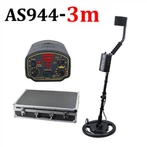Factors Affecting Measurement Values and Corresponding Solutions
1. Boundary spacing
If the distance between the probe and the boundary, hole, cavity, or other cross-sectional changes of the measured object is less than the specified boundary distance, measurement errors will occur due to insufficient cross-section of the magnetic flux or eddy current carrier. If it is necessary to measure the thickness of the coating at this point, it can only be measured by pre calibrating on an uncoated surface under the same conditions. (Note: The new product has a unique function of achieving an accuracy of 3-10% through coating calibration.)
2. Surface curvature of the substrate
Calibrate an initial value on a flat comparison sample, and then subtract this initial value after measuring the coating thickness. Or refer to the following article.
3. Surface roughness and surface cleanliness
To obtain a representative average measurement value on a rough surface, multiple measurements must be taken. It is obvious that the rougher the substrate or coating, the less reliable the measurement value. To obtain reliable data, the average roughness Ra of the substrate should be less than 5% of the coating thickness. For surface impurities, they should be removed. Some instruments have upper and lower limits to eliminate those 'flying points'.
4. Force exerted on the probe measuring board
The force applied during probe measurement should be constant. And it should be as small as possible. To prevent deformation of the soft coating and a decrease in measurement values. If there are significant fluctuations in the activity, a hard, non-conductive, and thick hard film can be placed between the two if necessary. By subtracting the thickness of the film, residual magnetism can be appropriately obtained.
5. External constant magnetic field, electromagnetic field, and residual magnetism of the substrate
Measurements should be avoided near external magnetic fields that may cause interference. The residual magnetism may cause measurement errors to varying degrees depending on the performance of the detector, but such phenomena generally do not occur in structural steel, deep drawn formed steel plates, etc.
6. Ferromagnetic and conductive components in layer materials
When certain ferromagnetic components, such as certain pigments, are present in the coating, they can affect the measured values. In this case, the coating of the reference sample used for calibration should have the same electromagnetic characteristics as the coating of the tested object and be used after calibration. The method used can be to apply the same coating onto aluminum or copper plate samples, and obtain comparative standard samples after testing with eddy current method. It can also be purchased from relevant metrology and testing departments






